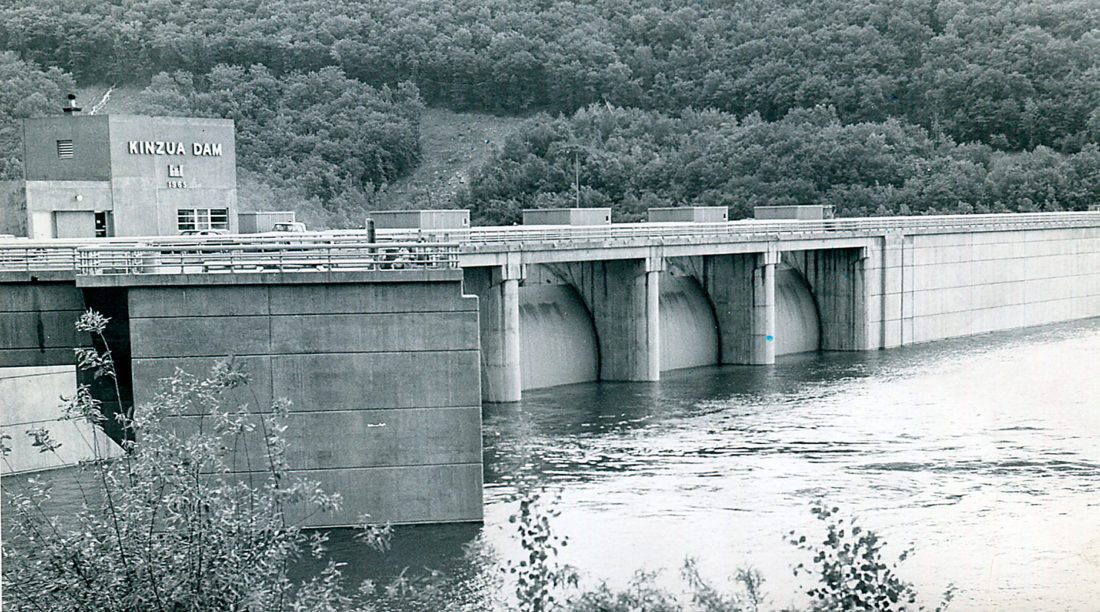The rains came…
And the floods went up – Times Observer file photos show just how much water Hurricane Agnes dropped

Times Observer file photo The Kinzua Dam at the height of Hurricane Agnes
Hurricane Agnes killed 128 people and inflicted $3 billion in damage stretching from the Yucatan Peninsula to New Hampshire.
Twenty-nine people were killed in Pennsylvania and 100,000 were evacuated.
The Miami Herald reported on Saturday, June 24, 1972, that the Allegheny River was rising at a level of seven inches an hour.
The Kinzua Dam came to less than three feet of its maximum capacity.
And the photos of the Dam taken at that time are almost unbelievable.
The Kane Republican called the storm a “once in a century,” in their Sept. 20, 1973 edition, which took a look back at the storm in 1972.
“As shown the dam is 1362.17 (feet above sea) level near its 1365 foot ‘full’ capacity,” the Republican reported.
“As great floods hit the upper Allegheny, the water was contained as designed by Kinzua Dam, preventing even greater disaster to downstream areas. The structure is monumental to U.S. Army Corps of Engineer planning. It is keyed to the East Branch Dam on the Clarion River and the Tionesta Dam in Forest County.
“All were “full up” during the run – off from Tropical Storm Agnes as greatest volume of water in history of floods was contained. Last September the Kinzua Dam was honored with the Don Neal award for “Doing The Most For Kinzua Country” and averting an estimated possible $100,000,000 damage from Agnes storm flooding.”
All of the Allegheny National Forest recreational facilities on the reservoir were closed “when the U.S. Forest Service reported the situation critical,” the Republican reported. “U.S. Forest Service officials this week confirmed that damage to facilities keyed to waters of Kinzua Dam involved a loss in excess of $1.4 millions.”
The level of the Allegheny Reservoir rose 34.17 feet in one week.
The Warren Rotary Club held a meeting in August 1972 where then-U.S. Army Corps of Engineers reservoir manager Jack Ewers was the keynote speaker.
Under the deadline “Kinzua Dam Saved Warren Area $1,290,000 Damage From Flood,” the Warren Times-Mirror reported that “Ewers gave a brief chronological history of what happened from the time Hurricane Agnes struck the Gulf Coast on June 19, then was unexpectedly driven up the East Coast and into Pennsylvania and New York State. In some areas rainfall during the catastrophe reached 15 inches. The average was in the neighborhood of 4.9 inches.”
In making the $1,290,000 estimate, Ewers said that the Allegheny River would have crested at 20.8 feet – a total that would have exceeded the 1956 flood by over two feet.
“Total savings from the flood in the entire Pittsburgh District watershed due to flood protection projects amount to over one billion dollars, according to careful studies, it was stated,” the Times-Mirror reported. “The Kinzua Dam’s share of ‘ these savings amounts to $247,300,000.”
“Total cost of construction for the Kinzua ” Dam is $107,700,000 so it paid “to build it just for this one flood,” Ewers said. “The Kinzua Dam was designed to contain two and one half times the 1956 maximum flood of record up to that time which it did very easily.”



